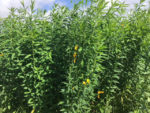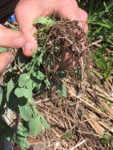The educational materials listed on this page are about Conservation Tillage.
Conservation tillage reduces soil disturbance by leaving more than thirty percent of the soil surface covered with the residue of a previous crop. This crop production system improves soil conservation, reduces soil erosion and limits water runoff. Producers can choose from several different conservation tillage systems no-till, strip-till, ridge-till or zone-till—based on their individual cropping system and on the amount of residue they want to leave on the soil surface. There is also a variety of tillage equipment available for farmers and ranchers, depending on which tillage system they use. No-till farming leaves all of the previous crop’s residue on the field. Farmers who use a strip-till system only disturb the section of soil that is necessary for seeding. Strip tillage is similar to zone tillage, but the latter cuts deeper into the soil to increase water infiltration. In ridge-till systems, farmers build raised seed beds to create a warmer seedbed with better drainage. Cover crops can be added to any conservation tillage system to provide additional residue and soil cover between cash crops.
Showing 1-2 of 2 results

Economics of Cover Crops II (Part 2): Benefits of Cover Crops and No-Till Vegetable Production in North Alabama
While the benefits of cover crops are similar regardless of cash crop, there are a number of benefits that are particularly important to vegetable producers. The main benefits of cover crops in vegetable production include increased organic matter; additional N through the use of legumes; suppressing disease, nematodes, and weeds; reducing soil erosion; providing habitat for beneficial insects; and improving soil tilth.

Soil Biology: Cover Crops and Disease Suppression
Cover crops provide several benefits to soil health such as improving soil structure, reducing the need for synthetic chemicals by decreasing weed biomass, increasing soil organic matter, contributing nutrients to the soil, retaining soil moisture, and decreasing soil erosion. In addition, the integration of cover crops into crop production often leads to soils that are suppressive to plant diseases (i.e. have less potential for disease development).